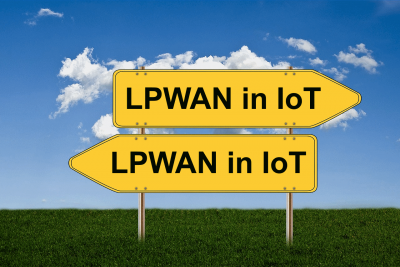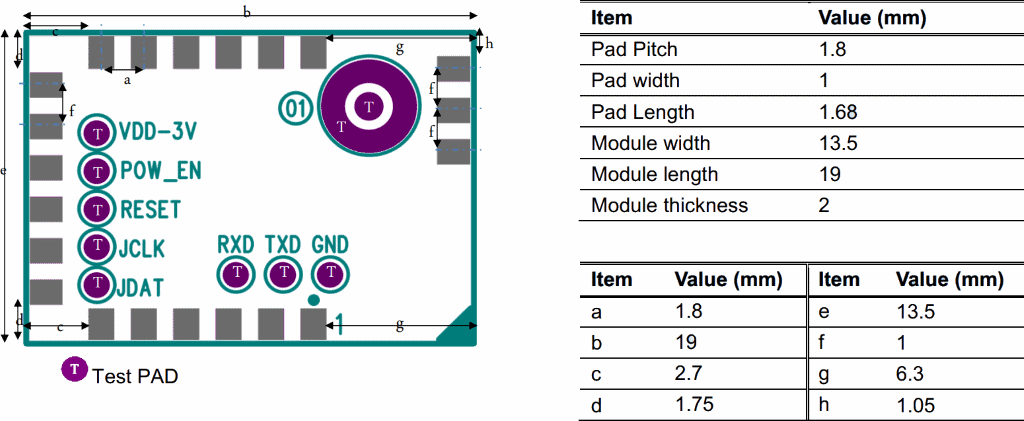In Germany, we have at least three companies, who plan to roll out an LPWAN. Two of them are on LoRa the other is on SIGFOX. One of the LoRa operators is backed by a big utility company. However, right now a standard IoT system integrator will not get access to the public LoRa networks in Germany easily.
Based on that I ordered my own SIGFOX Mini BTS. Anybody with a serious business use case can get one. My customer in Ireland sourced a SIGFOX Mini BTS as well. We have had a very fast roll out of SIGFOX in Düsseldorf region and 20 cities will get an indoor coverage. In addition, I got my hands on a SIGFOX module with the following features:
SIGFOX module as a glance
- 21 dBm @ 3,6 Volt
- 0,05 nA @ OFF
- 7 nA Idle
- 64 KB Flash for my own code
- SIGFOX protocol and encryption on the SoC
- PA with up 21 dBm on SoC
- Small footprint 19 mm x 13,5 mm and the option to get the plain SoC as well
- AT Command Interface on UART
- Migration path from 2G, 3G, 4G module to SIGFOX => remove cellular from the PCB and replace with a SIGFOX module
The operating voltage of my GSM modules is 3,4 to 4,2 Volt. The SIGFOX module is from 2,5 Volt to 6 Volt. A redesign will be pretty straightforward. End customers like city council are asking for SIGFOX and LoRa even when it makes no sense because there is no LPWAN coverage.
With the new SIGFOX Mini BTS concept, everybody can generate the SIGFOX coverage they want. On LoRaWAN we talk and on SIGFOX we do.
LPWAN Facts
Price for the LPWAN node
Presently no LPWAN module is cheaper than the new SIGFOX module or the SIGFOX System on a chip (SoC). Everything is on an IC (PA + transceiver + MCU + SIGFOX stack + space for my own code). There are 5 components around the SIGFOX SoC plus a matching circuit to the antenna. I plan to match directly with the PA because I do not care about the impedance. If necessary I will design a 200 Ohm antenna.
On LoRa I struggled to order product from Semtech. The LoRa IC is not a SoC. I aways require an MCU to run the stack. Inside a LoRaWAN module there is often an ARM MCU. In front of the module is another MCU (host MCU). There are a lot of parts around a LoRA IC, the power consumption in off mode is higher and the board space for a LoRa application is bigger.
Access to LPWAN network
To make a long story short, in the small village where I live there is no LPWAN coverage, but with SIGFOX I can satisfy the wishes of the city council.
Member of LPWAN association
“Device manufacturers must be a member of the LoRa Alliance to be LoRa Certified and must use one of the accredited LoRa Certification test houses to do the functional protocol testing.”
Source: https://www.lora-alliance.org/Products/Certification-Overview
Adopter Level: $3000
Source: https://www.lora-alliance.org/Join/Become-a-Member
To use GSM, UMTS and LTE I can do what I want. On NB-IoT (LTE-Cat-NB1) I need no membership as well. I am not aware that SIGFOX will ask for a membership fee. However $3000 is a lot of money for small companies.
Do you have news on what is going on in other countries? What is the status? Who is moving faster – LoRAWAN or SIGFOX?
And please do correct me if I am wrong. I am a human and not the Oracle of Delphi! . Thanks in advance for your feedback by comments or by email to harald.naumann (at) gsm-modem.de


http://thethingsnetwork.org/ open source LoRa infrastructure is moving fast, see e.g. http://ha-23.eradus.eu/croft.html gateway map.
Hello Harald,
there are two remarks and would like to add to your blog. the first one is, that you don’t mention anything about NB-IoT. In the battle of connectivity this is a solution to take into consideration. The second one is the possibility to build your own private LoraWan network. In the Netherlands the Lora frequency is public so everyone can build a private network.
Hi Pieter, I assume you are able to read the German language. End of September there will be a 7 pages article of mine in the biggest German magazine for electronics. The magazine is called “Elektronik” and it is a special edition on “Wireless”. The headline is:
“NB-IoT, NB-LTE oder LTE-Cat-NB1?” The article compare NB-Iot with GSM 900, SIGFOX, LoRa, Weightless P on 14 dBm and Weightless P on 27 dBm. The magazine you can grab free of charge at http://m2m-summit.com . I will stay at the stand of my employer. SIGFOX will stay as well. Weightless SIG sponsored it with a free of charge base station to me. I will lauch world smallest and cheapest SIGFOX module, world first NB-IoT Module on LCC and world first NB-IoT adapter for Arduino, STM32 Nucleco and Intel Galileo. And my new LoRa and LoRaWAN modules you can touch at as well.
SIGFOX in Germany
SIGFOX will offer 85% coverage by population in Germany.
LoRaWAN in Germany
There is a test only. You and I can not place an order with the German LoRaWAN operators. LoRaWAN in NL has not LoRaWAN in Germany. Pieter, we are neighbours. Something that will move to Germany will be lost.
LoRa in Germany
LoRa is not LoRaWAN. LoRa is just a physical layer.
Weightless P
Weightless P offers close the same link budget like LoRAWAN. We talk about 1 dB. 20 Byte on LoRa (not LoRaWAN) will take at spreading factor 12 and bandwidth of 125 KHz 1,2 seconds air time. Weightless P will charge 0,4 seconds on 12,5 KHz only. LoRaWAN is taking 200 KHz bandwidth. This is 16 times more than LoRaWAN. 1,2 seconds is 3 times more than LoRaWAN. 16×3 = 48. LoRWAN is 48 times worst than Weightless P. If 500 cars on LoRa (not LoRaWAN) will start at the home base, then this will take 500 x 1,2 seconds time = 600 seconds = 10 minutes.
LoRa frequency
There is no LoRa frequency. It is on 868 MHz ISM band. LoRa on SF 12 with 125 KHz bandwidth is not allowed to run on 870 – 875,6 MHz, 470 MHz or 169 MHz because in this bands you are limited to 12,5 KHz to 50 KHz bandwidth.
LoRa versus MoRa versus LoEn
LoRa is a registered trade made of Semtech and is the acronym for “Long Range”. MoRa is the acronym for “More Range” and LoEN is the acronym for “Low Energy”. 1,2 seconds TX will charge much more energy than 400 mS on TX. We talk about 3 times more power.
Free Weightless Ignition Packs
I have a closer look on Weightless P. The Weightless Ignition Packs are exclusively available to Weightless Developers free of charge. For more information about Weightless-P and access to the offer in conjunction with CTIA. Read more: http://try.weightless.org/naumann
I do not know have many they will offer. It looks that I was the first in Germany
IoT / M2M Cookbook – How to develop a device based on Low Power Wide Area Network modules
The proofreading for 12 new pages of the “IoT / M2M Cookbook – How to develop a device based on Wireless Wide Area Network modules” is in UK in progress. I already started the next “IoT / M2M Cookbook – How to develop a device based on Low Power Wide Area Network modules”.
Correct me if I am wrong.
I will be glad to meet you at http://m2m-summit.com as well.
Regards from Germany
Harald
Hi Thomas,
Please not that I normally erase posting with links only. My comparison to LoRa as below. TheThingsNetwork is on LoRa. Not LoRaWAN. This is even worst than LoRaWAN because you are limited to the number of messages dramatic.
Weightless P
Weightless P offers close the same link budget like LoRAWAN. We talk about 1 dB. 20 Byte on LoRa (not LoRaWAN) will take at spreading factor 12 and bandwidth of 125 KHz 1,2 seconds air time. Weightless P will charge 0,4 seconds on 12,5 KHz only. LoRaWAN is taking 200 KHz bandwidth. This is 16 times more than LoRaWAN. 1,2 seconds is 3 times more than LoRaWAN. 16×3 = 48. LoRWAN is 48 times worst than Weightless P. If 500 cars on LoRa (not LoRaWAN) will start at the home base, then this will take 500 x 1,2 seconds time = 600 seconds = 10 minutes.
LoRa versus MoRa versus LoEn
LoRa is a registered trade made of Semtech and is the acronym for “Long Range”. MoRa is the acronym for “More Range” and LoEn is the acronym for “Low Energy”. 1,2 seconds TX will charge much more energy than 400 mS on TX. We talk about 3 times more power.
TheThingsNetwork limitations
The TTN Fair Access Policy limits the data each end-device can send, by allowing:
An average of 30 seconds uplink time on air, per day, per device.
At most 10 downlink messages per day, including the ACKs for confirmed uplinks.
TheThingsNetwork limitations in reality
Golden rule: 30 seconds air-time per device per day
For 10 bytes of payload, this translates in (approx.):
20 messages per day at SF12
500 messages per day at SF7
more for SF7BW250 and FSK (local-area)
If your application requires more bandwidth, think of another solution
This allows for >1000 nodes per gateway
Downlink bandwidth is even more restricted
you can’t send all messages as ‘confirmed uplink’
Thomas, correte me if I am wrong
Best regards from Germany
Harald